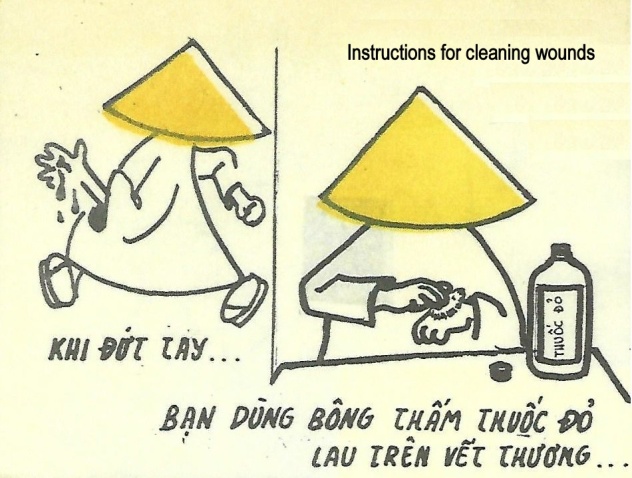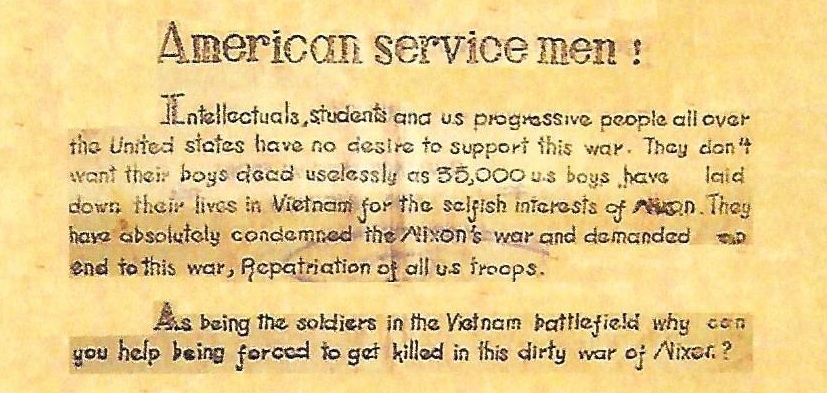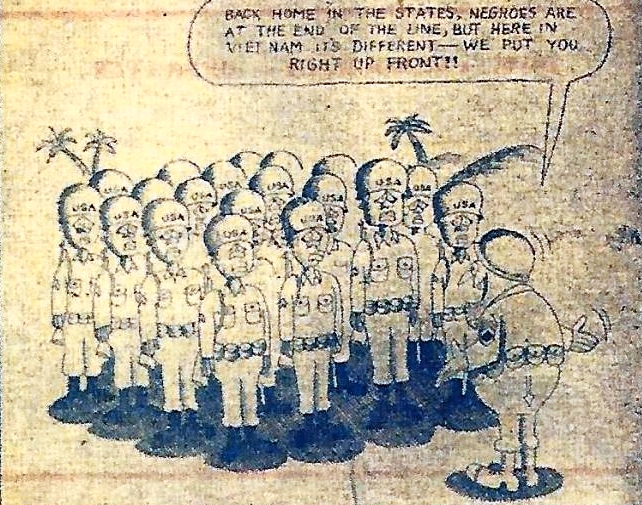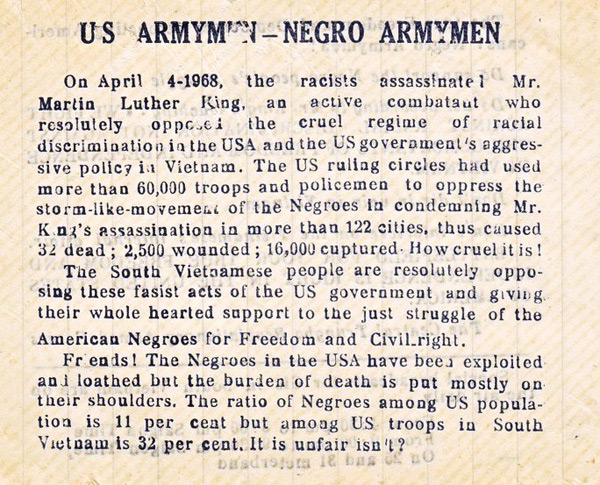 | ||||

EFECTIVENESS OF VIETNAM FLYERS AND PAMPHLETS
EFECTIVENESS OF VIETNAM FLYERS AND PAMPHLETS
I remember in 1966/1967, while I was running patrols with Second Battalion First Marines, American aircraft would drop thousands of propaganda leaflets over villages and hamlets. Sometimes they would drop several different ones at the same time; each with a different message.
Once a week a squad of Marines and I would set up a first aid area in a hamlet or village and I would give care to the sick and wounded. It was a civic action program called a MEDCAP. We also gave out flyers to the Vietnamese people, explaining the importance of hygiene and cleanliness.
Both sides used psychological methods to achieve what they wanted the other side to believe. The communists distributed pamphlets and leaflets through the South Vietnam National Front for Liberation group (NLF) telling our soldiers to get out of Vietnam that the South Vietnamese people didn’t want us there. They also told us that the American people didn’t want us in Vietnam. Below is an example of the propaganda they were spreading.


American leaflets were dropped from the air over selected targets, the Communists never had that ability. Therefore, Communist leaflets were usually left where it was thought that Americans would pass by; along trails, near base camps, and of in other locations where soldiers might congregate.
The VC would distribute their pamphlets during the night hours. Sometimes they were scattered in the direction we were headed so we would find them as we passed through that area. Other times a stake was punched through the flyer with the other end pushed into the ground.
Many of these leaflets were printed in Hanoi and shipped to both the battle front and the United States where they would be distributed by fellow-travellers and anti-war activists, probably Jane Fonda herself. Many were printed in the South by the Viet Cong and they are crude on poor quality paper. Other flyers were printed by the Vietcong printing machines which were very crude and primitive. However, they got the point across. By the way, many other pamphlets were printed from the University of California, Berkley; then sent to Vietnam and distributed by the Vietcong.
The purpose of enemy propaganda directed against US soldiers is to lower their morale and to lessen their desire to fight. The most common method of dissemination of this propaganda is the leaflet. Radio Hanoi and Liberation Radio also direct propaganda broadcasts at the US soldier. The VC has often chosen particular target groups within the US forces; for example, the Negro servicemen or the men of a particular division were likely targets. Most of the propaganda, however, is directed at the US soldier in general…
Let me give you an example of another flyer.

The flyer states, “Back home in the states, Negroes are at the end of the line,
but here in Viet Nam it’s different - - we put you right up front!!”
The picture above was from a flyer that was distributed throughout Vietnam. The flyers tried to drive a wedge between the black soldiers and the white soldiers. They were telling the blacks that they shouldn’t be fighting Whitey’s war. Why should they fight for a country that had enslaved them and discriminated against them throughout history? At the end of this article, I submitted more information on black history in Vietnam.
Hotel Company did have some isolated problems, but they were superficial. When you have Northern and Southern Marines living together, each were brought up differently in their own prejudiced ways. However, the Marine Corps was known for their discipline as we depended on one another for survival and to complete our mission. In my opinion, this particular propaganda did not work. The Marines depended on each other; we were brothers and respected one another.

There are six different functions of airborne leaflet propaganda that have been used over the past century:
1). Threaten destruction: Warn enemy combatants and non-combatants that their area will be targeted. This has the dual purpose of reducing collateral damage and encouraging enemy combatants and non-combatants (who may be engaged in wartime production) to abandon their duties, reducing the target's military effectiveness.
2). Prompt the enemy to surrender: Explain to prospective deserters how to surrender.
3). Offer rewards: Rewards would be offered to encourage individuals to provide assistance, or to encourage defection.
4). Disseminate or counter disinformation:
Reduce enemy morale through propaganda.
Neutralize enemy propaganda.
Advise radio listeners about frequencies/times of propaganda broadcasts and methods or circumventing radio jamming.
5). Facilitate communication: Create a friendly atmosphere for the enemy by promoting deologies such as freedom, capitalism, and "noble intentions".
6). Provide humanitarian assistance: Inform people where to find airdropped food, how to open and consume it, and when it comes.
More on black history…..
The Vietnam War saw the highest proportion of blacks ever to serve in an American war. During the height of the U.S. involvement, 1965-69, blacks, who formed 11 percent of the American population, made up 12.6 percent of the soldiers in Vietnam. The majority of these were in the infantry, and although authorities differ on the figures, the percentage of black combat fatalities in that period was a staggering 14.9 percent.
U.S. involvement in Vietnam unfolded against the domestic backdrop of the civil rights movement. From the outset, the use, or alleged misuse, of African American troops brought charges of racism. Civil rights leaders and other critics, including the formidable Dr. Martin Luther King, Jr., described the Vietnam conflict as racist—"a white man's war, a black man's fight." King maintained that black youths represented a disproportionate share of early draftees and that African Americans faced a much greater chance of seeing combat.
Black and white soldiers lived and worked side-by-side in the early years of the Vietnam War, and the generally good relations between them were a point of pride for the U.S. military. But this situation soon began to change. As black soldiers faced discrimination in duty assignments and promotions, their resentment toward white officers grew. At the same time, the high number of African Americans who were blacks often found themselves passed over for promotions. Only 2 percent of officers in the U.S. armed forces were black, even though blacks made up a much larger percentage of all military personnel during the Vietnam War.
I remember being on a patrol when leaflets started falling from the sky, one of our aircrafts was dropping them near a village we were walking toward. I grabbed a couple and later sent them home. As a matter of fact, I sent several different leaflets home and put them in a scrapbook after my tour. I have about forty different flyers in my collection.
This ends my brief look at the effectiveness leaflets, be it good or bad, both sides used it for their advantage. It was a very effective propaganda tool.